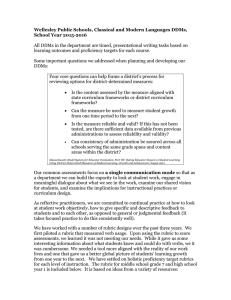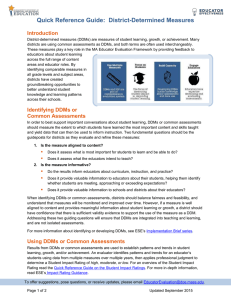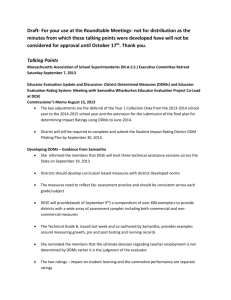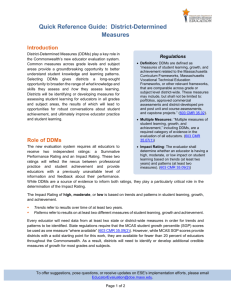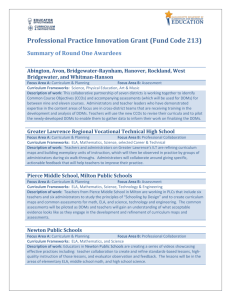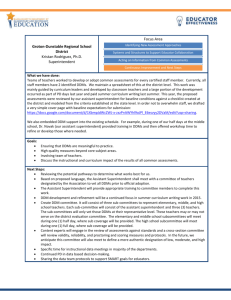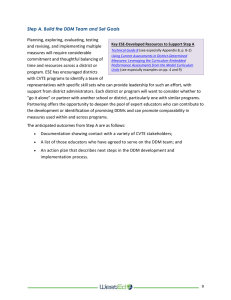TA1 PioneerValleyEdCollab
advertisement
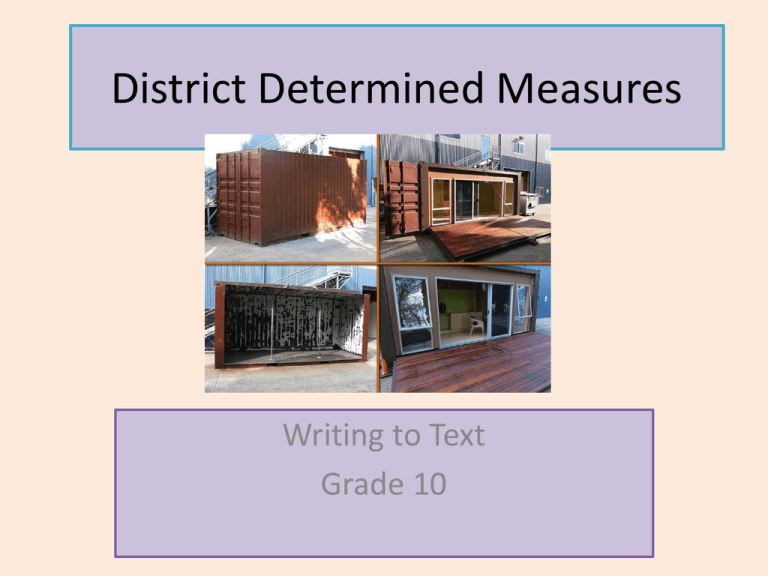
District Determined Measures Writing to Text Grade 10 Table of Contents • Define DDMs • Revised MA DESE Timeline for Implementation • Suggested Action Steps • Examining the ELA Frameworks – CCRs • Thinking about What to Measure • Developing the Rubric What are DDMs? • • • • Role of DDMs The new evaluation system requires all educators to receive two independent ratings: a Summative Performance Rating and an Impact Rating. These two ratings will reflect the nexus between professional practice and student achievement and provide educators with a previously unavailable level of information and feedback about their performance. While DDMs are a source of evidence to inform both ratings, they play a particularly critical role in the determination of the Impact Rating. The Impact Rating of high, moderate, or low is based on trends and patterns in student learning, growth, and achievement. – – Trends refer to results over time of at least two years. Patterns refer to results on at least two different measures of student learning, growth and achievement. Revised Implementation Timeline Revised Implementation Timeline In 2013-2014, all districts must research and pilot DDMs for some grades and subjects. o At a minimum, districts must pilot at least one DDM that is aligned to the Massachusetts Curriculum Frameworks in each of the following areas: (1) early grade (K-3) literacy, (2) early (K-3) grade math, (3) middle grade (5-8) math, (4) high school writing to text, and (5) traditionally non-tested grades and subjects (e.g., fine arts, music, p.e.). By September 2013, all districts must report to ESE: o The identified potential DDMs the district will pilot during the 2013-2014 school year and the grades and subjects to which they are aligned; o The grades and subjects for which the district has not identified potential DDMs and will research and/or develop measures to pilot in spring 2014. By February 2014, districts must report a final plan for determining Impact Ratings for all educators by the end of the 2015-2016 school year based on the identified DDMs. District Planning Activities • Districts should be actively engaged in the process of identifying and selecting appropriate DDMs. The following suggested steps will help districts position themselves for success: • Identify a team of administrators, teachers and specialists to focus and plan the district’s work on DDMs. • Assess educators’ understanding of the basics of how the MCAS Student Growth Percentile is derived and how it can be used to understand student growth and progress; develop a plan for ensuring educator understanding. • Complete an inventory of existing assessments used in the district’s schools and assess where there are strengths to build on and gaps to fill. • Discuss with the district’s educational collaborative, or other district partner, its interest and capacity to assist member districts in the work of identifying and evaluating assessments that may serve as DDMs. • Plan a process for piloting DDMs where potential measures have been identified. • Plan a process for researching and/or developing measures where no existing measures are deemed appropriate. • Create (or augment) the district’s communication plan to ensure that educators, school board members, and other stakeholders understand the role that DDMs will play in the new evaluation framework as well as a timetable for implementation. Designing a Measure College and Career Readiness Anchor Standards for Writing College and Career Readiness Anchor Standards for Writing The pre-k–5 standards on the following pages define what students should understand and be able to do by the end of each grade. They correspond to the College and Career Readiness (CCR) anchor standards below by number. The CCR and grade-specific standards are necessary complements—the former providing broad standards, the latter providing additional specificity—that together define the skills and understandings that all students must demonstrate. Text Types and Purposes‡ • 1. Write arguments to support claims in an analysis of substantive topics or texts, using valid • reasoning and relevant and sufficient evidence. 2. Write informative/explanatory texts to examine and convey complex ideas and information clearly and accurately through the effective selection, organization, and analysis of content. 3. Write narratives to develop real or imagined experiences or events using effective technique, well-chosen details, and well-structured event sequences. MA.3.A. Write fiction, personal reflections, poetry, and scripts that demonstrate awareness of literary concepts and genres. Production and Distribution of Writing • 4. Produce clear and coherent writing in which the development, organization, and style are appropriate to task, purpose, and audience. 5. Develop and strengthen writing as needed by planning, revising, editing, rewriting, or trying a new approach. 6. Use technology, including the Internet, to produce and publish writing and to interact and • collaborate with others. Research to Build and Present Knowledge 7. Conduct short as well as more sustained research projects based on focused questions, demonstrating understanding of the subject under investigation. • 8. Gather relevant information from multiple print and digital sources, assess the credibility and accuracy of each source, and integrate the information while avoiding plagiarism. 9. Draw evidence from literary or informational texts to support analysis, reflection, and research. Range of Writing 10. Write routinely over extended time frames (time for research, reflection, and revision) and shorter time frames (a single sitting or a day or two) for a range of tasks, purposes, and audiences. Note on range and content of student writing To build a foundation for college and career readiness, students need to learn to use writing as a way of offering and supporting opinions, demonstrating understanding of the subjects they are studying, and conveying real and imagined experiences and events. They learn to appreciate that a key purpose of writing is to communicate clearly to an external, sometimes unfamiliar audience, and they begin to adapt the form and content of their writing to accomplish a particular task and purpose. They develop the capacity to build knowledge on a subject through research projects and to respond analytically to literary and informational sources. To meet these goals, students must devote significant time and effort to writing, producing numerous pieces over short and extended time frames throughout the year. What do we measure and How do we measure it? Key Takeaways Whenever possible, district-determined measures of student learning should measure growth, not just achievement, and should measure the direct outcome of student learning rather than indirect outcomes such as promotion or graduation rates. To qualify as a district-determined measure, an assessment must be administered across all schools in the district where the same subject is taught and must be able to differentiate high, moderate, and low growth. The rating of an educator’s impact on student learning must be based on trends and patterns: at least two measures in each year and at least two years of data. Breakout Session I • Teams meet to discuss a specific CCR relevant to district growth. • Report out Reading and Writing • Reading: CCR 1, 4 • Writing: CCR 1, 4, 9, 2B • Identifying components – Use of evidence to support argument – Quality of thesis or argument – Organization – Comprehension – Language and convention Consider the following • • • • • • • • Many educators follow this sequence of questions when they plan their work on behalf of students: What do I most want my students to know and be able to do by the end of this course/year? What assessments are available to assess my students’ learning and growth? Where are my students starting? What do I expect them to achieve by key milestones throughout the year (e.g., by first quarter, second quarter, etc.)? How will I chart each student’s progress along the way so I can know how to re-group for the purposes of re-teaching, enrichment, and/or acceleration? How did my students do? What should I do differently next time? How did the results of my students compare to others’? What do I need to do differently next time? MA Model Curriculum Units at a Glance • The development of Model Curriculum Units involves teams of teachers delving deeply into the MA Curriculum Frameworks to identify and target groups of standards. Using the standards, the teachers chosen to serve on these teams are engaging in rich discussions to define the following elements of high quality curriculum design: – – – – – – – – – • • • Transfer Goals Enduring Understandings Essential Questions Knowledge Skills Curriculum Embedded Performance Assessments (CEPA) Other forms of assessment e.g. formative, summative, quick writes, observation, running records, etc. Learning Plan Lesson plans The lesson plans illustrate a well-structured, ordered approach to instruction, including text and digital resources. Moreover, lesson plans include elements of lesson study through which teachers are expected to reflect upon the successes and challenges of each lesson Each unit includes curriculum-embedded performance assessments aligned with the targeted standards and designed to elicit rich evidence of student learning. Analysis of this data in conjunction with other types of assessment will serve to inform instructional next steps. All participating educators will actively engage in a pilot of the units. Part of this process will include the collection of feedback on the curriculum and instructional components of the unit, collection of student data, collaboration with colleagues, and adjustments to the unit. Example from PARCC http://www.parcconline.org/samples/item-taskprototypes Rubric Template Pre- and Post- Testing to capture growth Breakout Session II • RubricMaking • Report out: Examples from districts Anchor Paper Process • 1) Administer assessment. • 2) Trainers score a set of papers as anchors. • 3) Trainers pull a packet of papers to use as training papers. • 4) Trainers share rubric and anchor papers with teachers. Teachers practice scoring on the training packet and compare scores with group to calibrate. • 5) Develop instructions for teachers. • 6) Develop scoring sheets (print or electronic). • 7) Trainers spot check for group calibration. • 8) Final component scores on Excel spreadsheet. Scoring Method • It is recommended that the essays are first scored relative to each of the five components of the rubric. • These scores will be developed by examining the subtopics within each category of the rubric. • The component scores will be useful to teachers as they draw conclusions regarding students’ learning strengths and weaknesses. • The component scores should be used to establish a teacher’s impact on student learning.

